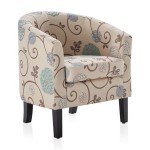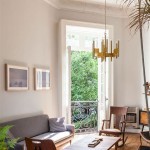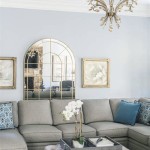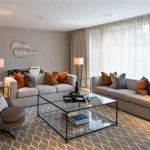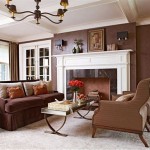Living Room TV Placement: Mastering the Corner Configuration
Placing a television in the corner of a living room presents both challenges and opportunities in interior design. It is a configuration often necessitated by room layout, window placement, or simply a desire to maximize space. Effectively integrating a television into a corner requires careful consideration of viewing angles, furniture arrangement, and aesthetic harmony. This approach can transform a potentially awkward space into a functional and visually appealing entertainment hub.
The corner placement strategy is particularly relevant in smaller living rooms where wall space is limited. By utilizing the corner, the television avoids dominating a primary wall, potentially freeing up that space for larger furniture pieces, artwork, or windows. This can result in a more balanced and spacious feel. However, successful implementation requires addressing potential drawbacks such as awkward viewing angles and potential glare issues.
A key consideration is the selection of appropriate mounting hardware. A standard flat wall mount is generally unsuitable for corner installations. Instead, articulated mounts, designed specifically for corners, are essential. These mounts allow for adjusting the television's angle, ensuring optimal viewing from various seating positions within the room. The size and weight capacity of the mount must be carefully matched to the television to ensure safety and stability.
Optimizing Viewing Angles and Distance
One of the primary challenges of corner TV placement is optimizing the viewing angle. A television placed directly in the corner often presents a narrow viewing cone, making it difficult for viewers seated on the sides of the room to have a clear image. This issue can be mitigated by using an articulated mount, allowing the television to be angled towards the main seating area. Experimentation with different angles is crucial to finding the sweet spot that accommodates the majority of viewers.
Viewing distance is another critical factor. As a general rule, the optimal viewing distance is approximately 1.5 to 2.5 times the diagonal screen size of the television. For instance, a 55-inch television should ideally be viewed from a distance of 7 to 11.5 feet. Corner placement can sometimes lead to a viewing distance that is either too close or too far. Adjusting the seating arrangement and potentially choosing a different television size can help to achieve the optimal viewing distance.
Beyond the general guideline, personal preference should also be taken into account. Some individuals prefer a more immersive experience and prefer to sit closer to the screen, while others find this uncomfortable. Trialling different seating arrangements and distances before finalizing the layout is highly recommended.
Another aspect of viewing angle optimization involves the height of the television. The center of the screen should ideally be at eye level when seated. This minimizes neck strain and provides the most comfortable viewing experience. The height of the television should be adjusted based on the height of the seating and the angle of the mount.
Consider the natural light sources in the room. If a window is directly opposite the corner where the television is placed, glare can be a significant problem. This can be mitigated by using blackout curtains or blinds to control the amount of light entering the room. Alternatively, the television can be angled slightly to avoid direct reflection.
Strategic Furniture Placement
The arrangement of furniture around a corner-mounted television is paramount to creating a functional and aesthetically pleasing living room. The primary seating should be positioned to face the television, with consideration given to the viewing angle and distance. A sectional sofa can be particularly effective in a corner arrangement, providing ample seating while defining the viewing area.
Avoid placing furniture directly in front of the television, as this will obstruct the view. If space is limited, consider using low-profile furniture or furniture with open backs to maintain a sense of visual openness. Coffee tables should be carefully chosen to ensure they do not interfere with the viewing experience or create a tripping hazard.
The placement of accent chairs and other secondary seating should complement the primary seating arrangement. These pieces can be angled towards the television while also encouraging conversation and interaction. The overall goal is to create a cohesive and inviting space that is both functional and stylish.
Consider the use of area rugs to define the seating area and create a sense of cohesion. A rug can help to anchor the furniture and create a more intimate and inviting space. The size and color of the rug should be chosen to complement the overall decor of the room.
In addition to seating, consider the placement of side tables and lamps. These pieces can provide convenient surfaces for drinks and snacks, as well as provide ambient lighting. The height and style of these pieces should be chosen to complement the overall aesthetic of the room.
Think about incorporating storage solutions into the corner arrangement. A corner media console can provide a stylish and functional way to store media players, game consoles, and other electronic devices. It also serves to conceal unsightly cables and wires, creating a cleaner and more organized look.
Concealing Cables and Maintaining Aesthetics
One of the most common challenges of any television installation is managing cables and wires. When placing a television in the corner, this challenge can be amplified due to the limited space and the potential for cables to be visible from multiple angles. Effective cable management is crucial to maintaining a clean and aesthetically pleasing living room.
Several solutions are available for concealing cables. One option is to use cable management sleeves or conduits to bundle and route the cables along the wall. These sleeves can be painted to match the wall color, making them less noticeable. Another option is to use in-wall cable management kits, which allow you to run the cables behind the wall for a completely seamless look.
If running cables behind the wall is not feasible, consider using cable ties or clips to secure the cables to the back of the television and the wall. This will prevent the cables from dangling and creating a cluttered appearance. Choose cable ties that are reusable to allow for easy adjustments and modifications in the future.
A media console designed for corner placement can also help to conceal cables and wires. These consoles typically have built-in cable management features, such as holes or channels for routing cables. They also provide ample storage space for media players, game consoles, and other electronic devices.
Beyond cable management, consider the overall aesthetic of the corner arrangement. The television should blend seamlessly into the decor of the room. This can be achieved by choosing a television with a sleek and modern design, and by incorporating accessories that complement the television's style.
Consider incorporating decorative elements such as plants, artwork, and candles to soften the look of the television and create a more inviting atmosphere. These elements can help to balance the visual weight of the television and create a more harmonious and balanced space.
The color scheme of the room should also be considered. Choose colors that complement the television and create a cohesive and visually appealing space. Neutral colors are often a good choice, as they provide a versatile backdrop for the television and other decorative elements.
Finally, consider the lighting of the room. Avoid placing lamps or other light sources directly behind the television, as this can create glare and make it difficult to see the screen. Instead, use ambient lighting to create a soft and inviting atmosphere. Dimmable lights are a great option, as they allow you to adjust the lighting to suit your needs.

When And How To Place Your Tv In The Corner Of A Room

When And How To Place Your Tv In The Corner Of A Room

A Case For The Corner Television Suess Electronics Appleton Wi

Problem The Only Place To Put My Tv Is In Corner Now What

A Case For The Corner Television Suess Electronics Appleton Wi

Corner Tv Design Ideas

18 Corner Tv Stand Ideas For Your Home

A Case For The Corner Television Suess Electronics Appleton Wi

How To Decorate A Wall Above Corner Tv With Tip And More

10 Small Living Room With Tv Ideas That We Want To Copy Asap


